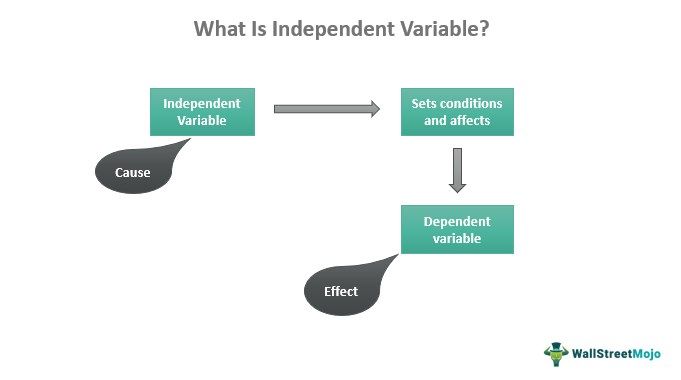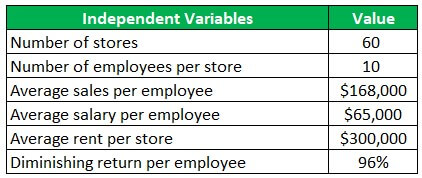Table Of Contents
What Is An Independent Variable?
An independent variable is an object, a period, or an input value. Changes are used to assess the impact on an output value (i.e., the end objective) measured in mathematical, statistical, or financial modeling.

Variable means something which will change as per available information. An Independent variable means information that is not dependent on any other input and is provided on a standalone basis.
Key Takeaways
- An independent variable refers to an object, a period, or an input value. The changes identify the influence on an output value (the end objective) measured in mathematical, statistical, or financial modeling.
- The independent variable is the selling price. The impact of a change in selling price is on the gross profit(dependent on selling price, direct cost, and the number of units).
- One may use the independent variable at the workplace, health research center, coaching classes, and school administration.
Independent Variable Explained
An independent variable, as the name suggests, remains out of the influence of other variables. These are independent and standalone entities in a research or study conducted. The variables constitute the condition that guides dependable units in research. In short, independent variables influence other variables, making them dependable.
An independent variable in research is important to detect the cause-and-effect relationships to study the external influences, thereby ensuring the study is conducted in a controlled environment so that no external influence affects it. This makes it easier for researchers to conclude how one variable affects another in the procedure.
As a result, the conclusion obtained identifies how the influence of variables can change the outcome or conclusion.
For example, the date of birth of a person is an independent variable for calculating the present age. It will not change based on many factors. In financial modeling, it can be an assumption for the number of units sold, a growth rate of sales or input for interest rate or a cost driver, etc.
Examples
Let us consider the following examples to understand how independent variables work and affect a study or research:
Example #1
Let’s consider an example of a famous company which sells its goods on a retail basis.

The impact of the said variable on the profit figures of the company is as follows:

Explanation
- Here the employee cost depends on the number of employees and the average salary per employee.
- Total revenue depends on independent variables such as the number of employees, average sales per employee, and diminishing returns per employee.
- Rental cost depends on the number of stores & rental cost per store.
- Total expense is dependent on salaries & rental cost. Further, the profits are based on total revenue & total expense. Similarly, profit % is on other factors, which are further dependent on the independent variables.
Example #2
We can consider the data as follows for the graph:

The independent variable is the selling price. The impact of change in selling price on the amount of gross profit (i.e. dependent on selling price, direct cost and the number of units) is below:

Explanation:
- The gross profit here is directly based on other factors.
- Any change in selling price affects the gross profit levels.
Uses
Exploring the uses below will make the independent variable definition better:

- Workplace – Independent variable can be used at workplaces wherein an employer needs to find whether providing different types of work to employees leads to increased satisfaction of their job profile or not. Such an experiment is conducted by providing a new set of work to one group of employees and a similar set of repeated work to other employees. Here, providing the work (new/repeated) to employees is an independent variable. The outcome depends on the input provided.
- Health Research – One can use it in a health research center where the doctors need to check the anxiety level/response of immunity to a new treatment for a set patient dealing with the same disease. For example, the experiment gave the new treatment to one group of patients and another treatment to another group of patients. Here, the type of treatment is an independent variable, which will provide the outcome (i.e., the level of anxiety in patients).
- Coaching Classes – One can also use the independent variable for a coaching classes environment wherein the coaching organization wants to check whether the students become attentive in class if the color of the walls changes from blue to light yellow. So, an experiment was conducted where one asked one set of students to study in the blue-colored hall and another group to study the same topic in a yellow-colored hall. Here, the color type is an independent variable.
- School Administration – One can also use an independent variable in a school wherein the head administrative wants to assess whether weekly extra-curricular (i.e., exercise) periods will help students to achieve more concentration in studies. So, in an experiment, one set of students was allowed weekly extra-curricular periods for 3 months, and they did not offer another set of students any additional periods. Again, the status depends on a quarterly test conducted in the school. Here, the extra-curricular periods are independent variables.
Independent Variable Vs Dependent Variable
Both dependent and independent variables have a significant role to play in the studies conducted from time to time. While the latter sets the conditions, the former abides by the same and becomes dependent on them.
Let us check out the differences between the two variables:
- Independent variables are conditions that act on dependent variables, while the other one is studied to check to what extent independent variables affect a relationship.
- As stated above, the former is standalone. On the contrary, the dependent variable is studied seriously as they depend on other variables and are greatly affected.

